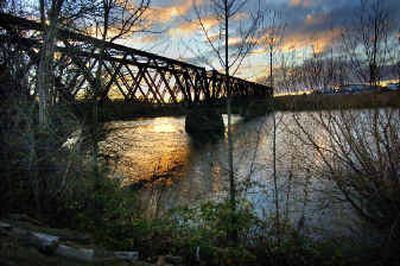Project would be a first

The developer of an office park east of downtown Spokane is applying to be the first in the city to use tax-increment financing to pay for improvements to his project’s streets, utilities and sidewalks.
Kent Hull would also like City Council approval to use the funding mechanism to improve the old iron railroad bridge spanning the Spokane River just north of Trent and Erie.
The City Council is scheduled to review the matter for the first time Monday, then vote on Dec. 20. If approved, the city would sell bonds for $850,000 worth of improvements to the 20-acre site.
The planned Iron Bridge campus is expected to eventually house more than 1,000 employees in 350,000 square feet of space spread over five buildings. The project would include parking, several acres of green space and connections to the Centennial Trail. It may also include a riverfront restaurant.
“The whole idea is to clean up this riverfront,” said Hull, whose company Iron Bridge LLC includes 10 investors. “The TIF (tax-increment financing) gives you a vehicle to get that done.”
The bonds would pay to construct turn lanes and signals, install a water main, pave and curb sidewalks, clean up the riverbank, install a paved walking trail and renovate the old railroad bridge.
Tax-increment financing works like this: The city sets geographical boundaries for the project, then issues bonds to pay for the work. Completed projects tend to increase local property values, which then increase property tax bills. Most of those extra tax dollars — 75 percent — would be used to pay off the bonds. Once they’re paid off, the taxing structure would return to normal.
The remaining 25 percent would be distributed to taxing districts, said Dave Mandyke, the city’s deputy director of public works. Taxes for schools would not be affected, he added.
As part of the project, Hull would renovate the old iron railroad bridge that crosses the Spokane River. Hull wants to use it to connect to the Centennial Trail and provide walking access between his project and the University District, Gonzaga University and the Riverwalk development to the west. It would provide a boon to businesses to the west, including restaurants looking for lunchtime customers, he said.
The reopening of the bridge is something the Logan Neighborhood Organization would like to see, said Donna McKereghan, chairwoman of the group. She called the run-down bridge a “hazard waiting to happen” and added that residents of Logan have been assaulted near that area. Renovating the bridge would make it safer and give nearby businesses an economic boost, she said.
“The Logan Neighborhood Organization supports the improvement of that bridge. We have for a long, long time,” she said.
Hull plans to extend the trail spur through the Iron Bridge campus north under the railroad tracks at Mallon and connect with the Tuffy Trail on the east side of the river, he said. That would provide walking and biking access as far north as the Community Colleges of Spokane, he said.
City Councilman Bob Apple, however, does not support using tax-increment financing. He opposes devoting taxes to a development that’s not a certainty, he said. “It’s still a subsidy no matter how you cut it,” Apple said.
Hull counters that tax-increment financing levels the playing field, considering Idaho has offered it for years. Washington approved the use of the funding mechanism in 2001.
At Iron Bridge, tax-increment financing would pay for a proposed $850,000 worth of improvements in a $36 million development, he said. Also, the law requires that Iron Bridge post a bond equal to the value of the improvements. If the additional taxes are not realized, that money is used to pay off the bonds.
The first Iron Bridge building, a 25,000-square-foot, two-story glass and brick structure, was completed at Trent and Perry last year. Now it’s almost entirely full, with State Farm Insurance occupying 80 percent of the building, Hull said. The second building, just to the west, is under construction. It will offer an additional 60,000 square feet, along with a parking garage.
Hull did not disclose potential tenants for that building.